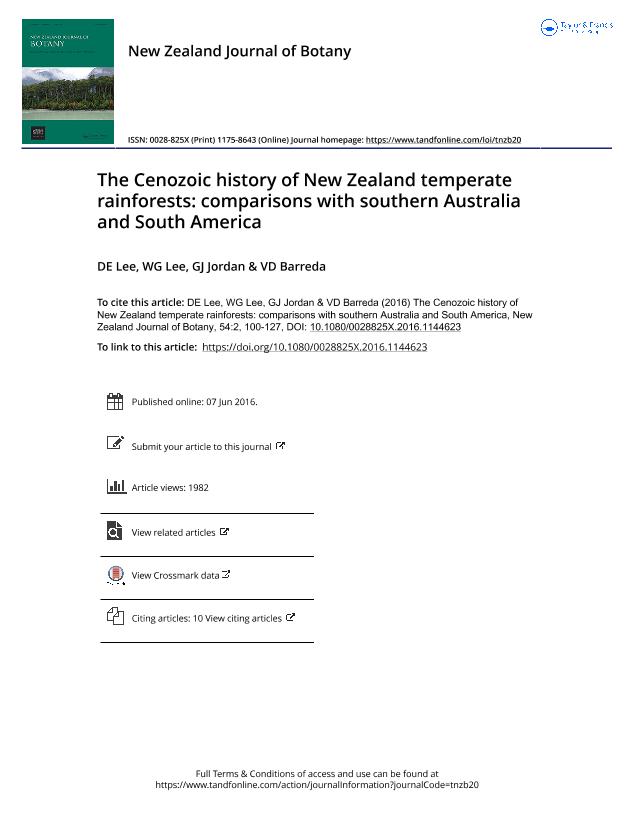Mostrar el registro sencillo del ítem
dc.contributor.author
Lee, D. E
dc.contributor.author
Lee, W. G.
dc.contributor.author
Jordan, G. J.
dc.contributor.author
Barreda, Viviana Dora

dc.date.available
2023-01-24T17:48:16Z
dc.date.issued
2016-04
dc.identifier.citation
Lee, D. E; Lee, W. G.; Jordan, G. J.; Barreda, Viviana Dora; The Cenozoic history of New Zealand températe rainforests: comparisons with southern Australia and South America; Royal Society of New Zealand; New Zealand Journal of Botany; 54; 2; 4-2016; 100-127
dc.identifier.issn
0028-825X
dc.identifier.uri
http://hdl.handle.net/11336/185447
dc.description.abstract
The temperate rainforests of southern hemisphere continents share Gondwanan antecedents, but subsequent trajectories exhibit divergent patterns. We review the Cenozoic history of major forest elements (c. 30 genera/families) of the temperate rainforests of New Zealand and compare these with South America and southeast Australia. From macro- and microfossil evidence, the major structural components of temperate rainforests in New Zealand have lineages dating back almost continuously to the Eocene or earlier. These include the tree ferns (Cyathea and Dicksonia), Agathis, all but one of the podocarps, Nothofagaceae and other broadleaved genera such as Lauraceae and Cunoniaceae. Collectively these taxa contribute approximately 50% of current biomass in New Zealand temperate forests. However, several previously important groups in the Cenozoic such as Araucaria, the Brassospora-type beeches, and Casuarinaceae became extinct in New Zealand in the Miocene to Pleistocene. Patterns of extinction are broadly similar in New Zealand and South America (mostly late Miocene to Pleistocene) in response to climate cooling along steepened environmental gradients whereas in southern Australia taxa became extinct later (Pleistocene) reflecting limited suitable habitat during glacials. The deep-time continuity evident in the composition of New Zealand temperate rainforests was not influenced by the decrease in land area during the maximum marine transgression in the late Oligocene (c. 25–24 million years ago). Forest canopy dominants and emergents appear to have remained remarkably stable, perhaps reflecting community resilience. However, new subcanopy and open habitat lineages arrived as forest taxa were extirpated and climates cooled, reducing potential forest habitats.
dc.format
application/pdf
dc.language.iso
eng
dc.publisher
Royal Society of New Zealand

dc.rights
info:eu-repo/semantics/openAccess
dc.rights.uri
https://creativecommons.org/licenses/by-nc-sa/2.5/ar/
dc.subject
BIOGEOGRAPHY
dc.subject
NOTHOFAGACEAE
dc.subject
PALAEOCLIMATES
dc.subject
PALAEOGEOGRAPHY
dc.subject
PALYNOLOGY
dc.subject
PLANT FOSSILS
dc.subject
PODOCARPACEAE
dc.subject.classification
Paleontología

dc.subject.classification
Ciencias de la Tierra y relacionadas con el Medio Ambiente

dc.subject.classification
CIENCIAS NATURALES Y EXACTAS

dc.title
The Cenozoic history of New Zealand températe rainforests: comparisons with southern Australia and South America
dc.type
info:eu-repo/semantics/article
dc.type
info:ar-repo/semantics/artículo
dc.type
info:eu-repo/semantics/publishedVersion
dc.date.updated
2023-01-24T10:22:20Z
dc.journal.volume
54
dc.journal.number
2
dc.journal.pagination
100-127
dc.journal.pais
Nueva Zelanda

dc.journal.ciudad
Auckland
dc.description.fil
Fil: Lee, D. E. University of Otago; Nueva Zelanda
dc.description.fil
Fil: Lee, W. G.. University of Auckland; Nueva Zelanda
dc.description.fil
Fil: Jordan, G. J.. University of Tasmania; Australia
dc.description.fil
Fil: Barreda, Viviana Dora. Consejo Nacional de Investigaciones Científicas y Técnicas. Oficina de Coordinación Administrativa Parque Centenario. Museo Argentino de Ciencias Naturales "Bernardino Rivadavia"; Argentina
dc.journal.title
New Zealand Journal of Botany

dc.relation.alternativeid
info:eu-repo/semantics/altIdentifier/doi/https://doi.org/10.1080/0028825X.2016.1144623
Archivos asociados
